As we walked across the staging area at this year’s Snow Shoot of the 2010 sleds, we passed dozens of Arctic Cat snowmobiles. We couldn’t help but get a little giddy with the prospect of being able to spend the next few days riding the iron laid out before us. That was just the beginning though, as things amped up once we stepped in to the trailer and started talking with the guys in green.
One thing we were sure of - the team behind Cat’s 2010 snowmobiles love to build, ride and sell snowmobiles. That passion is contagious and after just a few minutes with them you find yourself chomping at the bit to get on and ride. Luckily for us, that was exactly the plan.
Power of Four
For 2010, Cat’s catch phrase is “The Power of Four”. The four cornerstones to AC’s 2010 offerings are their Industry-Leading Horsepower, Body-Saving Ride Technology, Expert-Grade Mountain Sleds, and the World’s Fastest Snowmobiles. We did our best to experience all of them and Arctic Cat does a great job of delivering.
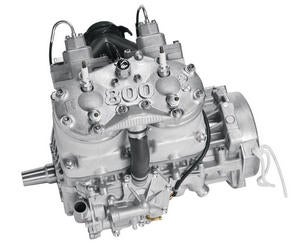 New 800 Motor
New 800 Motor
Arctic Cat offers a great line-up across all segments, but a couple of changes this year need to be mentioned right up front. For 2010 the green team has built a new 800 motor for us, and it is everything they claim it to be.
The new mill gets a 4.3 lb-lighter crankshaft, which was achieved by ‘pork-chopping’ the crank lobes. Now we always get nervous when someone tells us they shaved weight out of their crank shaft, but in this case it really does appear that there was a lot of extra weight in the crank that could be taken out without hurting durability.
But it isn’t just the crank that got a redo. The whole engine has been reworked and horsepower out of the twin mill touches the 160 hp mark, which is 10% more than last year's motor. We didn’t put it on a dyno, other than the ‘drag race it across the meadow and up the hill’ dyno, but that was more than enough to show us that the new Arctic Cat 800 motor is the strongest of the 800's available. It is quick revving and pulls hard all the way to the top end, making the sleds it sits in super fun to crack the loud lever on.
Entry Level Racing
The other thing that really caught our eye in the Arctic Cat camp was the new Sno Pro 500. Arctic Cat freely admits that they are targeting this little gem at the entry-level racer. It’s a very good trail sled, but with very little work you’ll be able to go racing with this Sno Pro. It’s especially attractive for those families wanting to give their younger riders a chance to get into cross country riding and racing, without spending a LOT of dough up front.
The Starting Line Up
Now let’s dive in and take a closer look at Arctic Cat’s 2010 offerings. There is a lot of good stuff there that we think offers something for everyone.
2-Stroke Performance
Arctic Cat doesn’t just throw a blanket to cover the 2-stroke performance class, they throw a big blue tarp over it. Light, fast, quick, fun, smooth all describe the offerings in this class.
Starting at the top we have the CFR1000. Take the 999cc 2-stroke twin and put it in a rigid, comfortable chassis and you pretty much define a trail rocket. With oodles of horsepower, great acceleration and quality ride we suggest you hold on firmly when cracking the throttle.
 We mentioned the 800 motor earlier and for 2010 Arctic Cat is giving you the chance at this motor in no fewer than four models. The CFR800, F8, F8 LXR and F8 Sno Pro give you options from entry-level capable sled to full-on racer-replica performance and handling.
We mentioned the 800 motor earlier and for 2010 Arctic Cat is giving you the chance at this motor in no fewer than four models. The CFR800, F8, F8 LXR and F8 Sno Pro give you options from entry-level capable sled to full-on racer-replica performance and handling.
Our test crew scored the CFR800 a 4.17 out of 5, a very good score. The CFR800 pulls super strong with the for-real 800 H.O. motor, and it shouldn’t surprise anyone that in categories like throttle response, power and performance, the CFR scored high. The seat is a little wider than our test crew would like, but handling and suspension are first rate.
If you want to step up the performance level, then step on up to the F8 sleds.
 Don’t be tempted to call the F8 a base model snowmobile … you’ll be in for a shock. All the F8s get Fox Zero Pro shocks, a wonderfully rigid chassis, good skis, push-button reverse and of course the new 800 motor.
Don’t be tempted to call the F8 a base model snowmobile … you’ll be in for a shock. All the F8s get Fox Zero Pro shocks, a wonderfully rigid chassis, good skis, push-button reverse and of course the new 800 motor.
The Sno Pro gets Fox Floats on the front and the LXR and Sno Pro both get the IRP adjustable handlebars and the super nice digital/analog combo gauge. The IRP adjustable bars are that silly simple design that allows you to raise or lower the bars as desired. There are still thousands of snowmobilers that see that design and think “Why didn’t I think of that?”. The LXR also gets electric start.
The F8 Sno Pro scored a 3.60 with our test riders, suffering from some poor suspension calibration. We didn’t mess with the suspension and it’s been our experience that the Fox Floats need to be dialed-in for the specific rider. For whatever reason, the sled seemed to be under-suspended, even for our lighter test pilots.
Wind protection is non-existent, which is probably to be expected on a race replica, but this sled still needs to be ridden on the trail.
But the F8 Sno Pro is nimble and “wails around corners”. It really is a dream to ride at speed through the tight twisties, handling everything we threw at it with predictability and smoothness.
And the motor - did we mention the new Cat 800? In the Sno Pro it wasn’t quite as snappy out of the hole, probably due to clutching, but it was still the new 800 under the hood and it gives you an instant smile when you roll out of a corner and crack the throttle open for the straight-away. We wouldn’t be shy about recommending the F8s to you… we would just mention that you’re going to have to do some calibration work on the suspension to fit your riding style and weight and if wind protection is a concern find a good aftermarket windshield and hand guards.
With all this talk about the 800 motor it might be a little tempting to over look the 600 class of sleds. That would be a sad mistake. The 2010 F6 Sno Pro sheds 8 lbs via a new seat and new skis. It also gets the IRP handlebars, better running boards, and improvements to the tunnel close-off which improve the heat exchanger. You still get the batteryless EFI 600, which is smooth and potent and of course you get the full Sno Pro treatment with Zero Pros and the digital/analog gauge.

Several of the Sno Pro changes are carried over to the F5 LXR including the new seat, running boards, rear tunnel close-off and the digital/analog gauge. The LXR gets very nice removable storage bags and the rest of the creature comforts that make LXR stand for luxury.
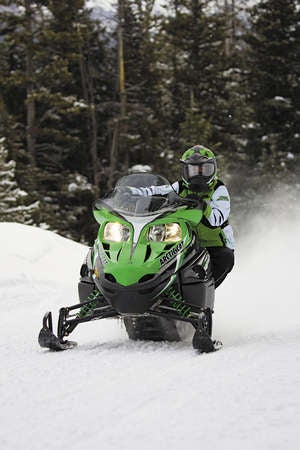 The F570 may well be the surprise value of the class. For 2010 the green team shaved 15 - yes, 15 - pounds off the fanner. That is quite the feat when you consider that the F570 Fanner was already pretty light. The weight reduction comes from the new seat, common on most of the Cat line-up, the addition of push-button reverse and changes to the tunnel and skis.
The F570 may well be the surprise value of the class. For 2010 the green team shaved 15 - yes, 15 - pounds off the fanner. That is quite the feat when you consider that the F570 Fanner was already pretty light. The weight reduction comes from the new seat, common on most of the Cat line-up, the addition of push-button reverse and changes to the tunnel and skis.
The F570 is nimble and light and is surprisingly strong running. Don’t count it out just because it’s the “value pick” and is a fanner. This little snowmobile holds its own against anything in the class and even some liquid sleds that are supposed to be better.
We mentioned earlier the new Sno Pro 500 from Cat and here we are again to talk about it a little more. There were few sleds at the Snow Shoot that caused as much buzz as this little fire cracker. Cat makes no bones about it, they wanted an entry-level race-ready ditch-banger that you can buy and go racing with little or no modifications required. The formula was pretty straight forward: Take the Sno Pro chassis with all of its goodies like Fox Zero Pro shocks, add in some specific changes to the suspension geometry to make it easier to steer and to handle flatter, then drop the 85 hp 500 twin EFI motor in there that runs on pump gas and is as durable as anything available.
What you get is a 450 lb package that packs plenty of punch for the weekend races or the weekend ditch banging. The only problem we see is that Cat may have to work extra hard to keep up with demand for this little runner.
F570 - $6,699
500 - $8,299
F5 LXR - $8,399
F6 Sno Pro - $9,899
CFR 8 H.O. - $10,399
F8 H.O. - $10,399
F8 H.O. LXR - $11,199
F8 H.O. Sno Pro - $11,199
CFR 1000 - $11,899
4-Stroke Performance
Ok, listen up. If you are looking for the ultimate go-fast performance sled available today then you need to go take a look at the Arctic Cat Z1s, specifically the Z1 Turbos. Hands down, there is nothing built by any of the OEMs that stacks up to the shear acceleration and top-end of the Z1 Turbo. Sure, maybe you can drop an additional $5,000-$7,000 on an aftermarket turbo or super-charger for one of the other sleds, but stock out of the box with a WARRANTY, you are not going to touch the Z1 Turbo.
But before we get too caught up in all of this, let’s take an orderly approach to life in the Cat 4-stroke world.

For 2010 the non-turboed Z1 comes in the Z1 and Z1 LXR. The Z1 is no slouch at 123 hp of reliable, smooth 4-stroke go. Cat put the new seat on it, made some changes to the exhaust and shod it with new skis to pull close to 20 lbs off the Z1. The base model Z1 will compete with any 4-stroke out there for smoothness and durability, and the LXR gets all the luxury touring add-ons like removable storage bag, new track, new more durable paint, Zero Pro shocks, IRP handlebar and yes, even a heated seat.
But if you are set on getting the most GO possible, then the Z1 Turbos will grab your attention.
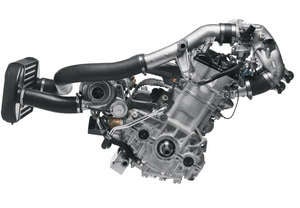 The Z1 Turbo is available in the base model, an LXR model, a Sno Pro model and new for 2010 is the Z1 Turbo EXT offering a longer (144”) track. The Z1 turbo mill is an impressive unit. It makes 177 hp and 121 ft.-lbs of torque. To truly appreciate that you have to experience it.
The Z1 Turbo is available in the base model, an LXR model, a Sno Pro model and new for 2010 is the Z1 Turbo EXT offering a longer (144”) track. The Z1 turbo mill is an impressive unit. It makes 177 hp and 121 ft.-lbs of torque. To truly appreciate that you have to experience it.
In one of our test sections of trail we could touch 85 mph at the end of the straight away. With the Polaris turbo we were able to bump in to the 95 mph range. But get on the Z1 Turbo Sno Pro and crack it out of the corner in our test section and you were north of triple digits and still pulling when you had to brake for the upcoming corner. Lag is nearly non-existent and power delivery is smooth and super-predictable.
The Z1 Turbo Sno Pro scored an impressive 4.13 composite with our test crew. More than one test rider got off the sled shaking his head and saying “Fast, incredibly fast”. On-trail performance was terrific, surprisingly good for a heavy sled. Our test crew had it out with several of the 2-stroke trail sleds and had no problem keeping up with the wannabe racers. On the straights we found the 2-strokers crying the blues about keeping up. And the Z1 Turbo proved to be pretty resilient after one of our test riders decided to roll it in an ice corner. The test rider came out of it worse off than the sled. We’ve ridden the wide smooth trails of Ontario, Canada and can’t help but long to get a few days there with one of these Z1 Turbo Sno Pros.
Like the other Sno Pros, wind protection is minimal and at cruising speeds nearing triple digits that is an issue. Hand guards or a better windshield would be one of the first accessories to add.

The Z1 Turbo EXT came in somewhat lower at 3.60. Don’t make the same mistake we did in thinking this is an off-trail sled. It isn’t. And to be fair, Cat isn’t selling it as an off-trail sled. It’s a heavy 4 stroke turbo that makes LOTS of power. In loose snow, even with the 144” track, you blow through the grip very fast. We played with it off trail in deeper snow and it really doesn’t work well there. And if you get it stuck, like with most 4-strokes, you’re going to need help getting it out. The on-trail performance is much better and the longer track smooths things out even more. But the design of the 144 makes for scary braking. Our test crew blew corners trying to get the EXT whoa’ed down. Seriously, if you buy one of these turbos give it the respect it demands and get familiar with it before you go sailing into corners at warp speed.
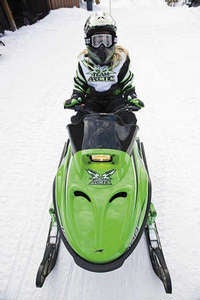 Finishing up the 4-strokes is the youth 120, the Sno Pro 120. The little Sno Pro has a real front and rear suspension which give your kids a comfortable ride. The 120 is engine-governed to 8 mph and it comes with a keyed ignition. Great value for the little rider just getting started and we’re glad Cat (as well as Polaris and Ski-Doo) continue to offer these little sleds.
Finishing up the 4-strokes is the youth 120, the Sno Pro 120. The little Sno Pro has a real front and rear suspension which give your kids a comfortable ride. The 120 is engine-governed to 8 mph and it comes with a keyed ignition. Great value for the little rider just getting started and we’re glad Cat (as well as Polaris and Ski-Doo) continue to offer these little sleds.
Z1 - $10,299
Z1 LXR - $10,799
Z1 Turbo - $12,899
Z1 Turbo LXR - $13,499
Z1 Turbo SnoPro - $13,699
Z1 Turbo EXT - $13,699
Sno Pro 120 - $2,499
Crossover
We’ve said it before and we’ll say it again. The crossover segment has become one of the fastest growing and most important segments in the snowmobile industry. We have already discussed the Z1 Turbo EXT and we aren’t going to lump it into the crossover segment. Instead, we’ll go with putting Cat’s offerings in to the crossover segment with the Crossfire lineup. Cat’s three models: the Crossfire 6, Crossfire 8 and Crossfire 8 Sno Pro offer a good mix, depending on your needs and wants.
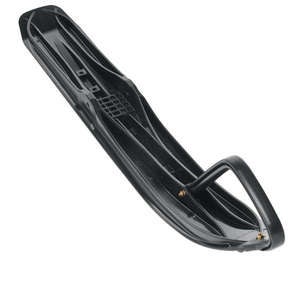 First off the Crossfire 6 gets a completely new ski that is 6” wide and 2 lbs lighter. Factory skis never seem to be up to the task, but this ski is a good piece that offers good cornering and isn’t overwhelmed by the longer track pushing it.
First off the Crossfire 6 gets a completely new ski that is 6” wide and 2 lbs lighter. Factory skis never seem to be up to the task, but this ski is a good piece that offers good cornering and isn’t overwhelmed by the longer track pushing it.
Speaking of track, the Crossfire 6 gets a single ply track for easier rolling and has push button reverse like most all of the other Cats. Ski stance is adjustable from 42-44 inches and the Crossfire sits on top of Fox Zero Pro shocks giving it a great ride.
Next up in the Crossfire line is the Crossfire 8 and 8 Sno Pro. Yup, these two sleds get the new 800 H.O. motor and they benefit from all that motor has to offer in its quick revving and hard pulling power. After losing 35 lbs in 2009 the 2010 Crossfire 8's drop another 6 lbs-plus, making them even better for those off-trail excursions. Like their sibling the Crossfire 6, the 8 gets new skis, push button reverse, and Zero Pro shocks. The Sno Pro upgrades to Floats on the rear suspension and IRP adjustable handlebar.
The Crossfire 8 scored 4.17 with our test riders, benefitting from the 800 H.O. motor’s performance. The open running boards were especially nice in the deeper off trail snow and even with the longer track our test riders found the handling and ride to be top shelf. The Crossover has the new Cat seat with its zippered rear pouch. It will easily hold most anything you want to put in there and it’s a very good use of the space. To give you an idea of how big the pouch is, we were able to roll the canvas sled cover up and stuff it in the pouch.

The sled we tested had black-on-black graphics and frankly they are a waste. You can’t even see the top graphics unless it is sitting in the sun and you look hard at angle. We’d suggest just a plain black hood with no graphics if you are looking for the blacked-out style. In our opinion, the 141” track isn’t enough track for the 800. 160 hp is a lot of go and we found it pretty easy to overwhelm that track under both acceleration and braking.
CROSSFIRE 6 - $9,199
CROSSFIRE 8 H.O. - $10,499
CROSSFIRE 8 H.O. - $11,299
Mountain
The mountain segment for Arctic Cat snowmobiles is once again dominated by the 800cc offerings. As with Polaris, after riding the turbo 4-stroke Z1, we were hoping to see a mountain version. But Cat didn’t choose to offer that for 2010. We can’t help but think that the first OEM to offer a factory turbo-charged 4-stroke mountain sled, with at least practical weight, is going to sell a stack load of them.
But we digress… the M sleds for 2010 have seen improvements and changes that will get you wanting to plunk down a big pile of your cash on a new stick. The M series sleds come in 600, 800 and 1000cc versions for this year. They get new lightweight and taller seats, the BOSS seat option of last year is gone, wider and lighter skis and FrogzSkin hood vent covers.
The M6 for 2010 drops another 7 lbs or so thanks to the seat and ski changes. The 600 mill remains the reliable smooth one we have become accustomed to and it pushes a new single-ply 153 track. Fox Floats are standard on the rear end with Zero Pros up front with ski stance adjustable from 39-41”.
 Our test riders found the M6 to be a nimble flickable fun sled to ride. The power is smooth and predictable although a bit on the weak side even for a 600. It didn’t have as much go as the Polaris 600, but was manageable. We missed the IRP handlebars on the 600 and we all thought, even those of us who are vertically challenged, that the bar location was a little low. The new seat is great on the M sleds, a little wide so you have to get used to getting your boot across it, but the copious amount of storage in it is a welcome addition in this day of little to know storage on a sled. The new Cat skis are probably the best OEM ski available. Our test crew scored the smallest M at a very good 3.98.
Our test riders found the M6 to be a nimble flickable fun sled to ride. The power is smooth and predictable although a bit on the weak side even for a 600. It didn’t have as much go as the Polaris 600, but was manageable. We missed the IRP handlebars on the 600 and we all thought, even those of us who are vertically challenged, that the bar location was a little low. The new seat is great on the M sleds, a little wide so you have to get used to getting your boot across it, but the copious amount of storage in it is a welcome addition in this day of little to know storage on a sled. The new Cat skis are probably the best OEM ski available. Our test crew scored the smallest M at a very good 3.98.
We’re going to jump right to the M1000 and hold off on the 800s for a minute.
The M1000 returns this year as a single model M1000 Sno Pro. Scoring a 3.89 from our test crew, the M1000 shines in the “I’m a big, bad-azz mountain sled” department. You can use all sorts of words to describe the M1000 like grunt, stump puller, monster, etc. There is no denying that this is one of the biggest mountain sleds out there. But for all the motor under the hood the M1000 rides and handles like a much lighter sled. Fox Floats adorn the suspension and as with the other M sleds it gets the new seat, skis and track. It’s a goin’ machine for sure.
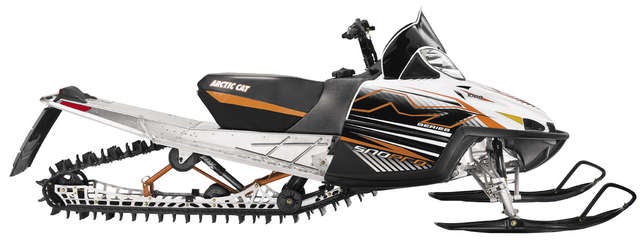
But as the 3.89 test score reveals, not all is exactly right with the big M. First and foremost the engine vibration is outrageous. Not since the thankfully dead-and-gone 900 Polaris have we experienced engine vibration like the M1000 has. For a couple of our test riders it was a deal-breaker, causing feet and hands to numb up after just a few miles in the saddle. Throttle calibration seemed way off on our test sled, with it being slow to rev and feeling like it took a while to get going. But once it spooled, hold on because it was going to go up whatever you pointed it at.
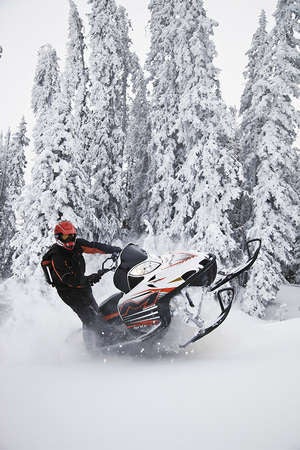 Which leads us to the M8 snowmobiles. Our first experience with the new 800 H.O. motor from Cat was in the M8. And to say we were impressed would be an understatement. The M8 comes in the M8 153, M8 Sno Pro 153, M8 Sno Pro 162 and the M8 HCR 153. The difference between the M8s is really in the options that come on them. The M8 base model is your entry point but still a superbly capable machine. But on the base model you don’t get the telescoping handlebar which is too bad and well worth the upgrade in our opinion.
Which leads us to the M8 snowmobiles. Our first experience with the new 800 H.O. motor from Cat was in the M8. And to say we were impressed would be an understatement. The M8 comes in the M8 153, M8 Sno Pro 153, M8 Sno Pro 162 and the M8 HCR 153. The difference between the M8s is really in the options that come on them. The M8 base model is your entry point but still a superbly capable machine. But on the base model you don’t get the telescoping handlebar which is too bad and well worth the upgrade in our opinion.
The M8 Sno Pro scored the highest of any sled we tested, coming in wiht a score of 4.44. There isn’t much bad to be said about this sled. It has oodles of go with the new 800 H.O. motor, it is “easy to flip around in the trees” and it “lays over and changes direction with just a thought”. Our test riders couldn’t get enough of this sled and we found ourselves wanting to get back on it over and over again.
In fact, we compared the M8 to the M1000 and we’re willing to bet that with the new 800 motor the M8 is nearly as potent in stock trim as the M1000, and it’s a lot more fun to ride with none of the vibration of the M1000 and all of the go. To put it simple, if you are looking for a mountain sled, you should buy the M8 Sno Pro.
And finally the Cat team rounds out the mountain segment with the M8 HCR. This sled, like the Polaris Assault and the Ski-Doo Hillclimb Edition are aimed more at the free rider and hillclimb racer crowd. The HCR scored in at a very good 4.27, benefitting from most of the positives of the M8 Sno Pro.
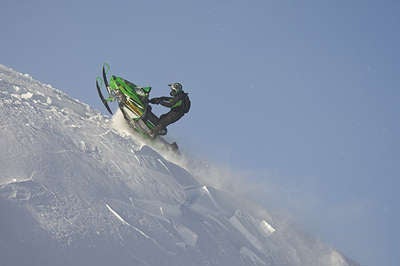 But things like the seat that was a positive on the regular M8, caused our test riders a little more grief when trying to truly pound on the HCR. And the wider ski stance of the HCR changed the hill manners enough that the test riders weren’t as favorable of the handling.
But things like the seat that was a positive on the regular M8, caused our test riders a little more grief when trying to truly pound on the HCR. And the wider ski stance of the HCR changed the hill manners enough that the test riders weren’t as favorable of the handling.
But once again that big GO in the 800 H.O. motor was there all the time and that was enough to put the smile on everyone’s faces. It’s a tough call - the HCR or the M8 Sno Pro… you’ll have to make that decision yourself. Either way, you win.
M6 153" - $9,399
M8 H.O. 153" - $10,699
M8 H.O. 153" SnoPro - $11,299
M8 H.O. 153" HCR - $11,999
M8 H.O. 162" - $10,999
M8 H.O. 162" SnoPro - $11,599
M1000 162" SnoPro - $13,199
Touring
The touring segment for Arctic Cat borrows technology from both the 2-stroke and 4-stroke performance models and then equips them with all the things you need and want in your touring sled.
The T570 is your entry-level touring sled and it sports the wonderfully-capable 570 fan-cooled 2-stroke motor. Push-button reverse, new seat, better skis and electric start give the budget minded touring rider all he or she needs. And of course there is a full line of accessories from mirrors to higher windshields to allow you to outfit your snowmobile as you want it.
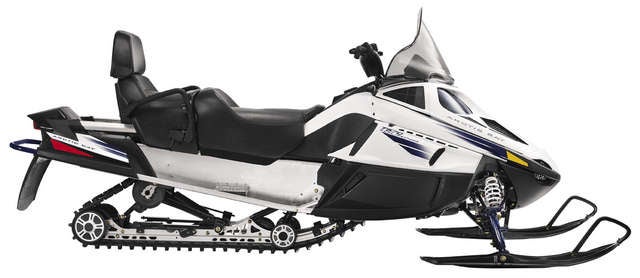
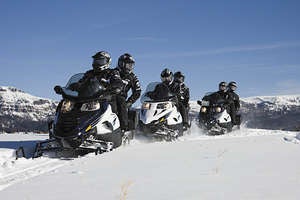 The rest of the touring line-up is built around the 4-stroke Z1 motor. You can choose from the TZ1 or TZ1 LXR which are powered by the non-turbo charged Z1 motor. They offer great performance, quality and durability while keeping the price down somewhat. They get all the upgrades and changes that the non-touring Z1s have, as well as adding the comfort features of a touring sled like longer track, 2-up seat and the like. And if you just have to have the extra power, well you can opt for the TZ1 Turbo.
The rest of the touring line-up is built around the 4-stroke Z1 motor. You can choose from the TZ1 or TZ1 LXR which are powered by the non-turbo charged Z1 motor. They offer great performance, quality and durability while keeping the price down somewhat. They get all the upgrades and changes that the non-touring Z1s have, as well as adding the comfort features of a touring sled like longer track, 2-up seat and the like. And if you just have to have the extra power, well you can opt for the TZ1 Turbo.
The LXR models get IFP gas shocks up front, IRP adjustable handlebar, remote electric start (dang cool), mirrors, storage bags, digital/analog gauge and both a driver and passenger heated seat. You want top of the line touring? These sleds are for you. But don’t forget that they are sitting on top of the strong Z1 motor and in the case of the Z1 Turbo, the fastest production sled around. So be cautious - we wouldn’t want your passenger screaming in your ear that you are going too fast.
T570 Touring - $7,399
TZ1 Touring - $11,099
TZ1 Touring LXR - $12,199
TZ1 Turbo Touring LXR - $14,799
Utility
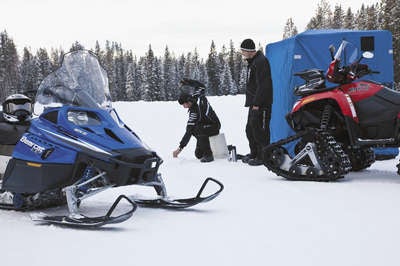 Chances are that either you or someone you know owns or is buying a utility sled. They have become a popular option for those people wanting to either work during the winter months in the outdoors or to use their remote cabin/recreation property year-round. The Arctic Cat Bearcat has been an integral figure in the utility segment for many years and Cat just keeps improving it.
Chances are that either you or someone you know owns or is buying a utility sled. They have become a popular option for those people wanting to either work during the winter months in the outdoors or to use their remote cabin/recreation property year-round. The Arctic Cat Bearcat has been an integral figure in the utility segment for many years and Cat just keeps improving it.
For 2010 the Bearcat is available in three models: two powered by the 570 fan 2-stroke and one with the strong Z1 4-stroke. Both of the 570s get new push-button reverse and an open pattern running board. The standard 570 gets a 15x151 track to go with its solo seat while the XT gets a 2-up seat standard and the 20x156 track. Because of the 2-up option of the XT, its suspension calibration has been reworked to offer better comfort for the 2-up user. The XT also has the articulating rear suspension with fiberglass overload springs, electric start and a detachable passenger seat. And fuel capacity on the XT is a whopping 17 gallons compared to the standard 570’s 10.8 gallons.
The Bearcat Z1 XT shares the 570 XTs feature list, with 17+ gallon tank and a beefier suspension to increase load capacity while offer a good ride quality. The Z1 Bearcat is a big, powerful work horse which will give reliable service that you can count on day in and day out.

It’s worth mentioning here that the list of accessory items for the Arctic Cat Bearcat line is about the most extensive we have ever seen in a utility sled lineup. From a 3-up seat to a snow plow - yes, snow plow - the options are pretty well endless.
BEARCAT 570 - $7,349
BEARCAT 570 XT - $8,799
BEARCAT Z1 XT - $11,799
Miscellaneous Ramblings
Once again Arctic Cat has impressed us. Across the board, the 2010 Cat line-up scored better than any of the other manufactures’ sleds in our test rider evaluations. Cat is doing an awful lot of things right with their sleds and continue to make improvements that impress.
If you browse through the segment listings you will come to the realization that the big 1000cc 2-stroke twin in the Cat line-up is becoming pretty scarce. Before we rode the sleds we were a bit surprised by that, but after getting some seat time on the Z1 Turbo and on the 800 H.O. we have come to realize that the 1000cc mill is starting to show its age a bit. Now if Cat can do for 2011 to the 1000 what they did to the 800 this year, well, now that would be something.
Assuming the 800 H.O. is a durable piece of iron, the other snowmobile OEMs better take notice and step up. Cat now owns the strongest 800cc motor in the business, no doubt about it. And putting it in so many chassis’ and offering it throughout the line-up is a very smart move on their part.
Not everything is perfect in “Green” land, but that’s why there is always a new model year. For 2010 the team at Arctic Cat should be dang proud of what they have delivered.



 Your Privacy Choices
Your Privacy Choices